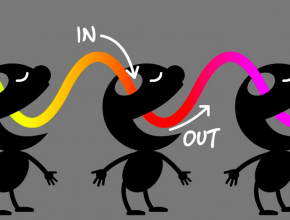Originally published in October 2012 in the magazine Chief Learning Officer (CLO)
We all learn … every day. It’s an essential capability, which has brought us rapid advancement as a species over the past several thousand years. Learning is even more important in today’s hyper-linked, inter-connected world wherein pertinent flows of information are accelerating.
In this context and set of conditions it’s critical that we learn continuously and effectively in order to adapt, and become more flexible and develop resiliency for a world of perpetual turbulence. As an analogy, think of a fast-flowing river with a lot of whitewater rapids. We now inhabit a world of permanent whitewater (for more on this, see Peter Vaill’s “Learning As A Way of Being: Strategies For Survival in a World of Permanent Whitewater)“.
How we learn may be changing, in dramatic ways
Most of us over the age of 20 have grown up and matured in an education-and-work system that offered us structured learning in the form of primary, secondary, and post-secondary education. This experience is/was followed by entry and integration into a highly structured hierarchical setting—our workplace(s). In both settings usually we had time to absorb, reflect, and be guided by more knowledgeable and/or more experienced people—teachers, supervisors, bosses, and occasionally mentors.
These conditions, which allowed us time to reflect, integrate and put to use what we learn, are now very rapidly changing in the era of the interconnected web. The use of search engines, databases, platforms, and spaces for collaborative exploration and exchange has exploded into our personal and collective world. Both real-time and asynchronous connection combined with effective technologies for compressing the bits that drive/carry audio and video have enabled inexpensive and effective telepresence. We’re transitioning into an era of “conversations” from which we extract useful information and knowledge, whilst time and space are being altered in front of our faces.
Arguably the capabilities offered by these new tools and the conditions they generate are having deep impact upon how, why, where, and when we learn. I think it’s “how” we learn that is the most important focus or issue for these early days of a new set of conditions rapidly becoming ubiquitous.
The flows of information enabled by interconnected technology and people typically involve exchanges of interest and pertinence to the activity at hand. However, in contrast to yesteryear, quite often the time available to learn has been affected in important ways. Does this help or hinder how we learn? Is it an obstacle, or just a condition to which we must systematically adapt through awareness and a shift in our frame of reference about learning?

In the context offered by the digitally enabled workplace, as in the past, we are often hired for what we have already learned. Today this is still a major factor, but increasingly just as important is being able to demonstrate that we have learned how to learn. In the interconnected workplace full of continuous information flows, of course we bring what we have learned (bodies of knowledge, specific skills, familiarity with a discipline, a market or an industry, etc.). But we often face a need to learn quickly. We need to be able to assess the context and issue(s) in near real time, instantly tap into what we already know or connect with someone whom we know knows what to do, and then interact and exchange with others also focused on the issue.
Even without hyperlinks and screens clearly some kinds of learning still take time, reflection, and discipline. An example: I just spent a couple of hours with a friend who had a stroke 18 months ago. He has had to re-learn how to speak, which has taken, time, discipline and support from others. Other examples could include learning how to work on an engine, master a craft, and so on.
Adapting
So, how do we do both? Learn rapidly in near real time, and take the time, reflection, and practice to learn something useful that is unlearnable in real time?
In order to be able to do this effectively, we must become more adept at making clear and conscious distinctions about when and how to engage in:
– Responding quickly by tapping into known and existing pertinent knowledge we can call up with a click or two (databases, other people or other points of reference)
– Identifying and signalling (to others) that some time is need to stop, think, and figure things out
– Clarifying that something underway or in discussion needs to be “moved to the side” for further discussion and deeper learning before being pulled into the discussion or resolution of an issue
Over and above these decisions any individual must make, a core skill is the ability to ask good questions in non-intimidating ways, listen effectively, and always seek to be helpful and of use. It’s also critically important to know and understand how one learns and how to employ filters to help decide when and how to learn. The emerging field of digital literacy combined with PKM (personal knowledge management) are very useful enablers of more effective personal learning strategies and tactics.
In the information-and-hyperlink saturated workplace social networks we now inhabit, clarification, confirmation, and collaboration are but a click or two away. It’s mission-critical for individuals, groups, and organizations to be able to discern what kind(s) of personal learning strategies are necessary to survive and thrive in our new world of permanent information whitewater.
There just isn’t any choice other than continuous learning because ongoing change —permanent whitewater— is our only remaining constant.
Laisser un commentaire